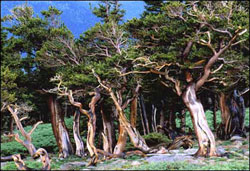Trees: Magnificent structures
Roland Ennos
Limits to the heights of trees

Like other plants, trees grow in a different way to animals. Animals have a set pattern of development that produces a full-grown adult with a preordained body plan: a set number of legs, for instance. Plants, in contrast, are modular organisms that can produce large numbers of almost autonomous branches, twigs and leaves. They could theoretically keep growing forever. Yet trees do in one respect show a pattern of growth that is very similar to animals. They have an S-shaped growth curve, growing slowly when young, much faster at intermediate ages, and slowing down as they mature until they level off at a maximum height. So why do trees stop getting taller?
There must be a genetic component, because some tree species grow taller than others: oaks are bigger than hollies. However, there must also be a connection with the environment, because trees of the same species reach very different heights depending on where they are growing. An oak tree growing in good soil in lowland Britain grows rapidly and can reach up to 30 metres in height, while one of the gnarled oaks of Wistman's wood on upland Dartmoor, in southwest England, by contrast, grows slowly and reaches only around 10m. Similarly, Sitka spruce trees grow up to 60m tall in California, but trees of the same species growing in Alaska rarely reach 10m.

Bristlecone pines Pinus longaeva are extremely hardy trees that grow on semi-arid mountains from the Mexican border northwards to Colorado, where their growth is limited by the extreme cold and drought. (Image: John Shaw/Auscape)
Poor conditions reduce both growth rate and maximum height. Several theories have been put forward to explain what limits the height of trees.
Respiration hypothesis
One theory is that trees grow more slowly as they get taller because they have more wood to maintain. Therefore, as trees grow, more of their photosynthetic production has to be diverted to allow the trunk, branches and structural roots to respire; eventually all of the sugars will be needed just to maintain them and the tree will stop growing. This theory certainly ties in with the correlation between tree growth rates and maximum heights; fast-growing trees produce more sugars and so could maintain a larger trunk. However, recent research has contradicted this theory; wood is so full of dead material that it requires only around 5-12 percent of the sugars to maintain it, even in large trees. In any case, the theory cannot explain the fact that the trunks of mature trees continue to increase in diameter long after they have reached their maximum height.
Nutrient-limitation hypothesis
Coppicing
Coppicing is a technique that makes use of the fact that many species of angiosperm trees, such as hazel (hazelnut), chestnut, oak and ash, do not die when they are cut down. Instead they sprout buds from around the base of the trunk to produce large numbers of narrow poles. Growth of these poles is very rapid because the tree already has a fully developed root system to supply it with water and nutrients, and there is no trunk to use up energy or reduce the water supply to the leaves. Coppicing therefore promotes the production of large numbers of narrow woody stems that can be harvested every ten years or so; they are used to make poles, hurdles, tool handles and other small implements, or may be burnt as firewood or to make charcoal.
Coppicing as an industrial practice became economically unviable in the early twentieth century, but the practice is currently making a come-back in woodlands owned by conservation bodies because it promotes high species diversity. In any one wood, only a small proportion of the coppice is cut each year, so the woodland is a patchwork of coppice of different ages; the habitat will range from newly harvested areas which form an ideal habitat for light-loving flowers and butterflies, to heavily shaded areas where more typical woodland vegetation is favoured.
A second theory is that tree height is limited by the availability of nutrients. As trees grow, they take up nutrients and sequester them in their leaves and woody tissues; this reduces their availability in the soil. As a consequence, larger trees would have to divert more of their biomass to their roots to maintain the nutrient supply and they may not get enough to produce new leaves or branches. There is some evidence for this theory; older forests often do have higher root biomass than young ones, and their soils do tend to have lower nitrogen levels. Furthermore, adding more nitrogen to mature woodland can result in the trees resuming their vertical growth. However, the theory does not explain why young trees can grow perfectly well in old forests if they get enough light. Nor does it explain why parkland trees, which have plentiful nutrients and water, eventually stop growing. The theory cannot therefore be a complete explanation.
Maturation hypothesis
A third idea is that trees stop growing because the tips of their shoots, where the tree extends, mature, and their rate of cell division decreases. The slow-down is thus genetically programmed. Trees certainly mature; older shoots are less twiggy than young ones and have lower growth rates. These differences are genetic in origin as they remain even if a mature shoot is grafted onto a juvenile tree's rootstock. However, the transition to maturity occurs well before height growth slows down. In any case, shoots grow extremely rapidly from the bases of coppiced trees (trees that have been cut at the base of the trunk, a method which stimulates rapid wood production), even when they are several hundred years old. This shows that trees do not age and lose their vigour in the way the hypothesis suggests.
Hydraulic-limitation hypothesis
The theory that is best supported by the scientific evidence is that height is limited by the supply of water to the leaves. In taller trees there is higher resistance to water flow because it has further to go up the trunk and because it has to be raised higher against gravity. Because water is dragged up trees under tension, the taller the tree the higher the tension has to be; air bubbles are therefore more likely to form in the xylem vessels, causing loss of their conducting ability. To prevent this, taller trees have to close their stomata earlier in the day or earlier in a drought; this limits photosynthesis, and so slows tree growth.
All of the aspects of this theory have been verified by experiment. Taller trees do indeed have greater hydraulic resistance, and water is under greater tension in their trunks; their stomata do close earlier in the day, and tall forests do have reduced rates of water loss and photosynthesis as a result. What is more, the idea also helps explain three other facts. First, it explains why old trees have flattened tops with gnarled, slow-growing branches and twigs, whereas further down the canopy growth is more rapid. This occurs because photosynthesis and new growth are most severely reduced at the very topmost twigs where the hydraulic resistance is greatest. Second, it can also explain why trees growing in nutrient-poor habitats or in cold or dry conditions have a lower maximum height than trees of the same species that are growing in good conditions. These factors will reduce the growth rate of the tree, which will therefore lay down less new wood each year; the result will be a reduction in hydraulic conductivity, particularly since slow-growing trees lay down relatively more late wood, which has narrower cells. Future growth is consequently reduced and height is limited.

The giant redwood Sequoiadendron giganteum from the western slopes of the Sierra Nevada, California. Growing up to 96m, it is slightly shorter than the Californian (coast) redwood Sequoia sempervirens which grows up to 102m. (Image: Diccon Alexander)
Finally, the theory can help us explain why the two tallest species of tree in the world are the Californian (coast) redwood, Sequoia sempervirens, and the Eucalyptus trees of the Australian temperate rainforest. The climate is ideal for year-round growth in both areas: the eucalypt forest is relatively warm and has plentiful rainfall all through the year; in coastal California there is abundant winter rainfall, while in summer the trees obtain their moisture from the fogs that move in from the sea. Both areas also have fertile soils.
The evidence therefore suggests that limited water supply to the leaves is the most important factor that curtails tree growth. However, size is not everything, and many trees are adapted to be short. Small evergreens such as hollies and box trees thrive in woods under a canopy of larger species, while small deciduous trees such as rowans and birches are ideally suited to a life on wind-blasted heaths and moors. Small is definitely beautiful for the birches and willows of arctic tundra which reach only a few centimetres in height, so keeping out of the icy blast!
Toolbox

With our shark experts, Speedo developed a super-fast swimsuit – its special fabric mimics the microscopic features of sharks’ skin.
